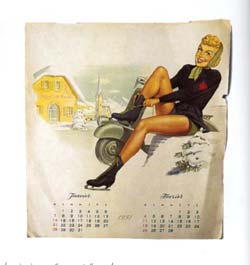Culture on two wheels
With a little help from American movie stars, the Vespa has become a powerful cultural symbol.
With a little help from American movie stars, the Vespa has become a powerful cultural symbol.
In April 1946, the first 15 Vespas rolled out of a factory in Tuscany, Italy. Since then, more than 16 million Vespa scooters have been sold to customers in 114 countries. Over the years, the company has introduced more than 100 models.
New, inexpensive – and magical
There are several reasons for the Vespa’s popularity. It was first marketed at a time when owning an automobile or other means of transport was an impossibility for most. It was also relatively cheap, although at first it was a luxury item few working-class families could afford.
“The scooter is much more than just an industrial product. In the post-war period it emerged as an important cultural symbol – an icon for dreams, freedom and fun”, says Thomas Brandt at the Department of History and Classical Studies at NTNU (Norwegian University of Science and Technology). Brandt studies the mythology that has grown around the Italian two-wheeler since it became a global success in the 1950s and 1960s.
The shaping of a symbol
Brandt says the scooter soon came to characterize both individual and cultural identities.
“Its symbolic dimension was shaped by the interaction between the manufacturer and Vespa owners”, he said. “Journalists, advertising designers, politicians and lobbyists also contributed to its mystique. All these groups helped develop the Vespa’s physical design, as well as the shaping of the Vespa as a symbol”.
Nowadays the Vespa is often associated with a young and trendy lifestyle. It wasn’t always that way. The first Vespa brochures were full of technical information, clearly aimed at grown men. It was not until the late 1960s that female scooter drivers became a mass phenomenon and the scooter was used not just for leisure, but for daily transportation to and from work.
Enter the apple
As the automobile gained ground, the scooter was increasingly left to the young. Gradually, the Vespa itself came to be a symbol of youth. But at first, the company had trouble marketing itself to youth culture. Young people as a market were «discovered» relatively late in post-war Italy as compared to countries such as England. Early advertisements aimed at this group were largely unsuccessful. But advertising designers did not give up. Instead, they discovered a simple solution: the apple.
The humble apple conjured up images of eroticism and rebellion, with its links to the Biblical story of Adam and Eve. This subliminal message appealed to young people. The campaign was a great success and sales skyrocketed. The Vespa apple later came to be associated with powerful images from the European student and youth movement of 1968. That, and the link between the Vespa apple and mankind’s fall from grace form a connection now fixed in Italy’s collective mindset.
American movie stars also helped make the Vespa into an icon. The two-wheeler was used in several films during the 1960s, and popular screen actors like Gregory Peck, Charlton Heston and Audrey Hepburn contributed to the sky-high demand for the scooter.
In recent years scooter nostalgia has flourished, fuelled in part by the publication of books that walk readers down memory lane. One book explains how the Vespa came to personify the aspirations of an entire society and that Italians used it as a vehicle for their vision of the future. The Vespa helped pave the way for post-war Italian society to join the modern world.
Even though sales have varied, the Vespa, unlike many other scooter brands, has managed to hold its own. With a brand name as durable as a Beatles song, this «little wasp» is now driving into its 57th year.
“The myths surrounding the Vespa are a sort of biography”, Brandt says. “If ever an autobiography of the modern Italian were to be written, the Vespa’s story would be a natural chapter”.
By Tore Hugubakken

